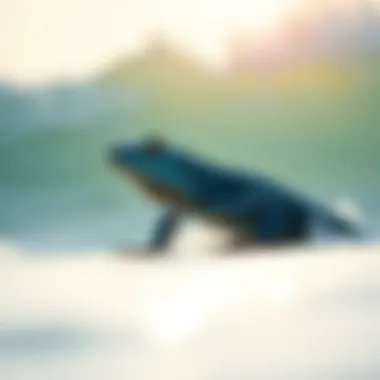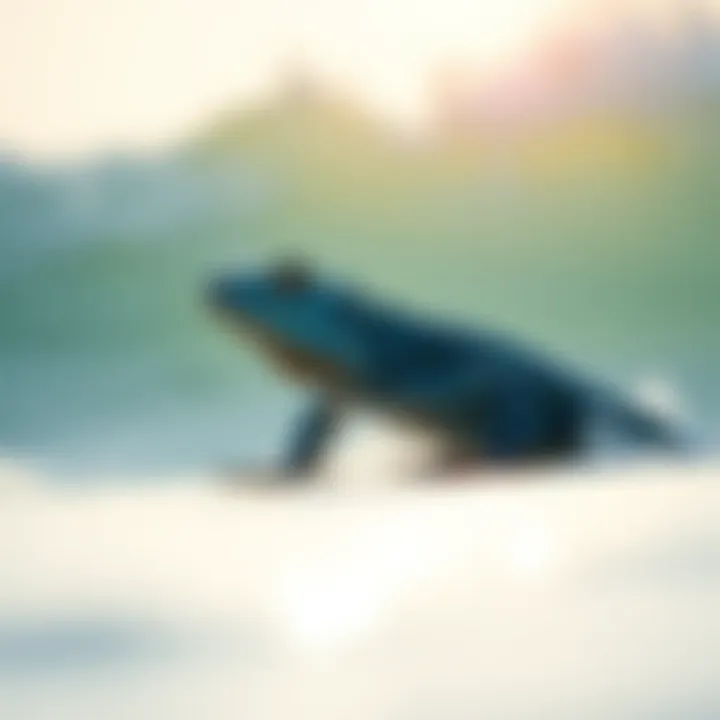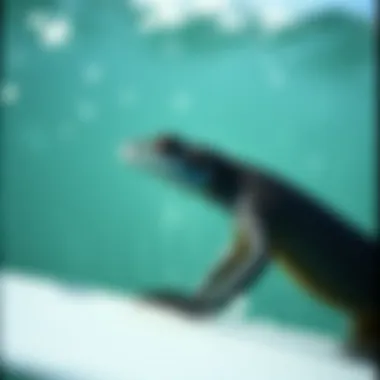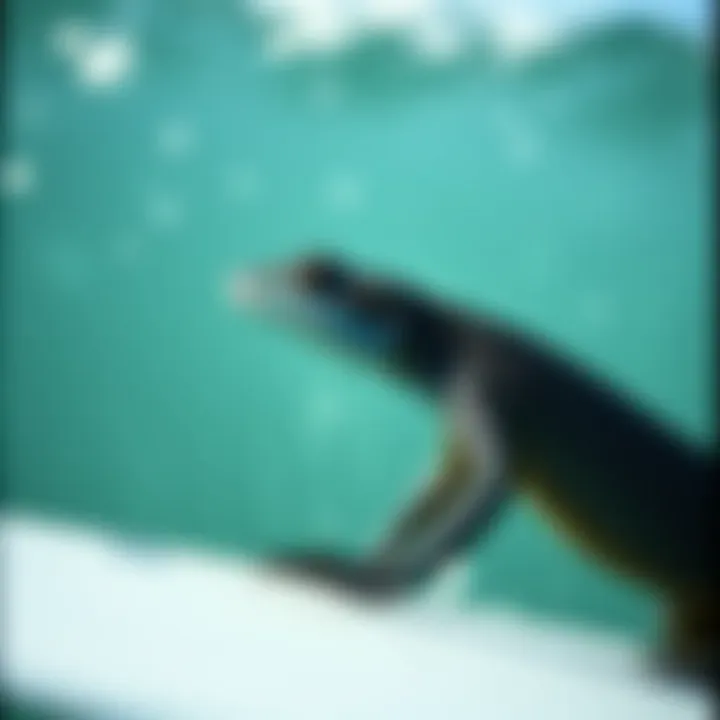Assessing the Environmental Impact of Blue Lizard Sunscreen


Intro
As the waves splash against the shore, surfers embark on their exhilarating quests. Yet, the seemingly inconsequential choice of sunscreen can unveil a significant impact on marine ecosystems. The quest for protecting our skin from the sun's harsh rays needs to be balanced with a sense of responsibility for the very waters we ride. Blue Lizard sunscreen emerges as a popular choice among outdoor enthusiasts, but how biodegradable is this product? This article endeavors to peel back the layers of its composition, scrutinizing its environmental implications, particularly in surf-heavy locales.
Living in a world that revolves around the ocean's beauty poses unique challenges. With every application of sunscreen, residues end up in the water, affecting aquatic life. The evolution of awareness regarding our environmental footprint has encouraged many to rethink their choices, especially surfers who find themselves directly interacting with marine biospheres. In this discussion, we explore the ingredients of Blue Lizard sunscreen, its claims pertaining to safety for marine habitats, and how surfers can adjust their habits in pursuit of conservation.
A diligent examination reveals the intricacies that characterize this sunscreen product. Let's delve deeper into the particulars of what makes Blue Lizard as appealing to consumers as it is challenging for the environment.
Preface to Sunscreen and Its Environmental Impact
Sunscreen plays a crucial role in protecting skin from harmful ultraviolet (UV) rays, allowing outdoor enthusiasts to enjoy sunlit activities while minimizing the risk of skin damage. As more people flock to the beaches and engage in water sports, the conversation about the environmental impact of sunscreen becomes increasingly relevant. These products, while beneficial for individual health, can contribute to broader ecological concerns, especially in marine environments.
Understanding how sunscreens interact with nature is not merely an academic exercise; it holds practical implications for preserving marine ecosystems. The chemicals found in many conventional sunscreens may find their way into oceans, affecting everything from coral reefs to marine life. The paradox is obvious: while people use sunscreen to protect their skin, they might inadvertently harm the underwater world.
The Role of Sunscreen in Skin Protection
When venturing outdoors, particularly to sunny landscapes or coastal regions, sunscreen serves as a frontline defender against UV radiation. This radiation is infamous for causing sunburn, premature skin aging, and even skin cancer. Mainstream products usually rely on either physical blockers, which reflect UV rays, or chemical absorbers that neutralize these harmful signals before they penetrate the skin. Both types possess their unique attributes and potential drawbacks.
For surfers and outdoor enthusiasts, finding an effective sunscreen is vital. The last thing anyone wants is to be caught in the sun without sufficient protection. Certain brands, like Blue Lizard, emphasize their formulations' effectiveness, promising robust UV blocking capabilities—crucial for those basking under the sun's harsh glare. However, as effective as these products are for skin protection, their formulation warrants scrutiny, especially their environmental footprint.
Concerns Over Chemical Ingredients
While the protective elements of sunscreen are significant, the ingredients used raise eyebrows among environmental advocates. Common chemical agents, such as oxybenzone and octinoxate, have come under fire for their potential to harm aquatic life. Studies reveal that these ingredients can contribute to coral bleaching, disrupt reproductive functions in fish, and harm other marine organisms.
Additionally, there’s a growing concern about the cumulative impact of these chemicals. Just picture the swirling waters filled with sunscreen residue after a day at the beach. It’s not only swimmers who are affected; the aquatic ecosystems bear the brunt of these interactions. Increasingly, consumers are looking for safer alternatives, prompting brands to innovate and consider biodegradable formulas.
"It isn’t enough to merely shield ourselves from UV rays; we also need to reflect on what we’re leaving behind in the ocean."
In summation, understanding the relationship between sunscreen application and its repercussions on the environment is imperative. As the world recognizes the pressing need to protect our marine ecosystems, it becomes clear that informed choices about sunscreen can have lasting impacts. The dialogue surrounding biodegradable products, such as Blue Lizard, helps ensure that the measures we take for personal protection do not come at the expense of environmental health.
Understanding Biodegradability
As the waves crash against the shore, many surfers may not ponder the lingering effects of their sun protection on the marine world beneath them. This section sheds light on the concept of biodegradability and how it shapes our view of skincare products like Blue Lizard sunscreen. Prioritizing understanding biodegradability isn’t just an academic exercise; it's about making choices that matter. In a world drowning in plastic and synthetic chemicals, knowing which products can be broken down by natural processes can lead to better decisions for both personal health and environmental well-being.
Definition of Biodegradability
Biodegradability refers to the capability of a substance to be decomposed by microorganisms, including bacteria and fungi, into natural elements in a safe manner. It's a rather straightforward yet essential concept that has profound implications for our planet. When we discuss products as biodegradable, it’s an assurance that these do not persist indefinitely in the environment, potentially causing harm.
In practical terms, a biodegradable sunscreen means that it will break down under specific conditions, typically within a few weeks to months, rather than sticking around for years, like many non-biodegradable chemicals do. This relates directly to environmental health, ensuring that what gets washed off in the ocean does not contribute to pollution.
Importance of Biodegradable Products for Marine Life
Every drop in the ocean counts, especially when it comes to marine ecosystems. The usage of biodegradable products is crucial for the well-being of underwater life. Main reasons include:
- Reduces Toxicity: Biodegradable products decompose into harmless constituents, meaning they don’t release toxic substances into the water that can harm fish and coral.
- Improves Water Quality: Sunscreens that break down properly lessen pollution in our oceans, helping to keep the waters clear and healthy for marine biodiversity.
- Safeguards Coral Reefs: Coral reefs are incredibly sensitive to chemicals. Biodegradable alternatives minimize damage to these ecosystems, which serve as vital habitats for countless marine species.


"Choosing biodegradable personal care products can significantly impact the health of the oceans, ensuring they remain vibrant and full of life."
In summary, understanding biodegradability equips us to make informed choices that align with both our skincare needs and our responsibility to protect marine environments. This creates a win-win scenario, where we can enjoy the sun while also being guardians of the oceans we love.
Overview of Blue Lizard Sunscreen
Understanding Blue Lizard Sunscreen is key to evaluating its impact on both skin and the environment. This particular brand has positioned itself within the natural sunscreen market, which has recently gained attention from environmentally-conscious consumers. With surfers and outdoor enthusiasts consistently exposed to the elements, choosing the right sunscreen becomes a crucial balance between skin protection and environmental responsibility.
Many users actively seek products that are non-toxic and ocean-safe. Blue Lizard not only caters to the skin protection needs but also highlights its commitment to minimizing environmental footprints. In a world where coral reefs face existential threats from pollution, using a sunscreen that limits harm can make a significant difference.
Company Background and Philosophy
Blue Lizard Sunscreen originated in Australia, capitalizing on the country’s long-standing tradition of sun safety due to its harsh UV conditions. Over the years, the company has embraced a philosophy rooted in safety and sustainability. Their commitment goes beyond just providing sun protection; they seek to promote a culture of respect for marine life and the environment.
This philosophy is not merely a marketing tactic. An emphasis on using safer ingredients means that each Blue Lizard product is crafted with the well-being of users and the earth in mind. The company produces mineral-based sunscreens, favoring zinc oxide, which is generally regarded as safer for corals compared to some chemical ingredients commonly found in conventional sunscreens.
Ingredients Used in Blue Lizard Sunscreen
The formulation of Blue Lizard Sunscreen stands at the heart of its environmental assessment. Understanding the ingredients can shed light on its biodegradability. Key components typically include titanium dioxide and zinc oxide. These ingredients are known for their efficacy in blocking UV rays while also presenting a lower risk for marine life.
On the other hand, Blue Lizard makes an effort to avoid certain chemicals that may leach into oceans and harm aquatic ecosystems. This contrast underscores the necessity for consumers to examine sunscreen labels closely.
Here’s a glimpse of some common ingredients found in Blue Lizard Sunscreen:
- Zinc Oxide: A physical blocker that safeguards the skin without the use of potentially harmful chemicals.
- Titanium Dioxide: Another mineral-based sunscreen active known for its UV protection capabilities.
This combination not only offers effective sun protection but also aligns with a growing demand for environmentally-friendly products. As consumers become more educated about the importance of biodegradability, brands like Blue Lizard can lead by example in an industry often criticized for its lack of ecological awareness.
Only by reassessing our choices can we protect both our skin and our oceans. This is where products like Blue Lizard Sunscreen fit into a more sustainable lifestyle.
In summary, Blue Lizard distinguishes itself in the overcrowded sunscreen market by focusing on both efficacy and ecological integrity. As such, evaluating the biodegradability of their product is not just about environmental responsibility; it's about contributing to the greater good of our planet.
Biodegradability Assessment of Blue Lizard Sunscreen
Understanding the biodegradability of any product is crucial, particularly for sunscreens like Blue Lizard, which have a direct impact on marine ecosystems. As environmental awareness rises, consumers are seeking products that lessen their ecological footprint, and sunscreens are no exception. Sunscreen chemicals can wash off into the water during recreational use, potentially affecting aquatic life. Evaluating biodegradability thus becomes an essential process—not just for environmental specialists but for everyday users who want to make informed choices.
Biodegradability reflects how well a product breaks down into natural substances over time. It represents a commitment to sustainability that resonates with many outdoor enthusiasts, especially surfers who are in constant contact with the ocean. By examining how effectively Blue Lizard’s ingredients decompose, we can gauge its suitability for those seeking eco-friendly options. Moreover, understanding these aspects helps lay groundwork for responsible consumption, which ultimately benefits marine life.
Evaluating the Ingredients for Biodegradability
When delving into the specifics of Blue Lizard sunscreen, it is essential to look closely at its ingredient list. Many sunscreens contain substances like oxybenzone and octinoxate that are notorious for being harmful to coral reefs and marine ecosystems. However, Blue Lizard formulates its products with a focus on minimizing these impacts. Some of the ingredients, such as zinc oxide, are generally recognized for being less damaging to the environment.
Here’s a list of key ingredients found in Blue Lizard Sunscreens:
- Zinc Oxide: A mineral-based sunscreen agent that is safer for corals.
- Titanium Dioxide: Another mineral that biodegrades fairly well and is less harmful.
- Plant-based compounds: Helps in moisturizing while providing sun protection, contributing to a healthier overall formula.
To precisely evaluate the biodegradability of these ingredients, one has to consider factors including their chemical structure and how they interact with the environment. Ingredients that are soluble in water may break down quickly, whereas those that are built to resist environmental degradation might persist longer, potentially leading to ecological harm.


Research Studies on Blue Lizard’s Environmental Impact
Beyond scrutinizing the ingredients themselves, various studies have assessed the broader impact of Blue Lizard sunscreen on the environment. Research has shown that products formulated with biodegradable ingredients can reduce damage to marine life, specifically coral reefs that face threats from harmful chemicals found in traditional sunscreens. Some studies have illustrated that mineral-based sunscreens, like those from Blue Lizard, have a significantly lower toxicity level in aquatic environments.
"Choosing sunscreens that are biodegradable is paramount not only for protecting our skin but also for safeguarding marine ecosystems."
For example, a recent study highlighted how traditional chemical sunscreens contributed to coral bleaching—a phenomenon that weakens coral and disrupts entire marine ecosystems. In contrast, research on Blue Lizard indicates its formula supports marine health, aligning with consumer trends towards environmentally responsible products.
The scrutiny of Blue Lizard’s production processes and ingredient effects shows a positive trend in environmental consideration. Such studies provide further assurance for surfers and aquatic enthusiasts that their choices matter, impacting both their health and the ecological integrity of their beloved habitats.
In sum, the assessment of Blue Lizard sunscreen’s biodegradability not only highlights its commitment to sustainable practices but also reinforces the important role consumers play in protecting the marine environment. Understanding these aspects opens the door to making informed, eco-friendly decisions while enjoying the great outdoors.
Comparative Analysis with Other Sunscreens
The discussion surrounding the biodegradability of sunscreen isn’t just limited to what’s inside the bottle. Comparing Blue Lizard sunscreen with other brands sheds light on the broader landscape of sun protection products, revealing trends, benefits, and drawbacks. It's crucial to establish a clear understanding of how Blue Lizard stacks up against both conventional and eco-friendly options. This analysis guides consumers—especially those in the surfing community—who prioritize both skin health and environmental well-being.
Comparison with Conventional Sunscreens
When evaluating conventional sunscreens, it’s important to dig into their typical ingredients, many of which are known for their potential harm to marine ecosystems. Sunscreens that contain oxybenzone and octinoxate are notorious for their role in coral bleaching and disrupting aquatic life. In contrast, Blue Lizard has made strides to formulate products that steer clear of these problematic chemicals. This difference in formulation is not just a feather in their cap; it reflects a growing recognition of the environmental impacts linked with traditional chemical sunscreens.
- Direct Harm: Conventional sunscreens often fail to biodegrade, leading to harmful chemicals persisting in the ocean.
- Coral Reefs at Risk: The active ingredients in many mainstream brands, unlike those found in Blue Lizard, can contribute significantly to the decline of coral reefs.
- Public Awareness: As consumers become more educated about these issues, they lean towards sunscreens with safer profiles, often gravitating towards options like Blue Lizard.
In essence, the choice for surfers and marine enthusiasts isn't merely about getting the best sun protection but about selecting products that align with their values—protecting both skin and sea.
Evaluation Against Other Eco-Friendly Brands
The eco-friendly sunscreen market is burgeoning, with multiple brands vying for the attention of beachgoers who are keen on preserving natural habitats. Evaluating Blue Lizard against these eco-conscious contenders reveals specific merits and areas for improvement.
While many eco-friendly brands tout certifications or innovative biodegradable elements, not all are equally effective in shielding skin from harmful UV rays. In a head-to-head with similarly positioned brands like Badger or Thinksport, Blue Lizard stands out due to its commitment to durability in sun protection without compromising on environmental safety.
Key Considerations:
- Effectiveness: Some eco-friendly sunscreens may lack the necessary SPF ratings, thus requiring users to balance safety with performance.
- Ingredient Transparency: Unlike some competitors, Blue Lizard provides comprehensive information about its formulations, engendering trust among consumers.
- Sustainability Practices: While assessing other brands, it's essential to consider their entire manufacturing process—from source materials to packaging.
Impact of Sunscreen on Coral Reefs
The significance of understanding the impact of sunscreen on coral reefs cannot be overstated. Coral reefs, often referred to as the "rainforests of the sea," harbor a diverse array of marine life. They are not only critical for oceanic ecosystems but also provide essential benefits for coastal communities, including protection from storms and a source of income through tourism and fishing. However, the damaging effects of certain sunscreen chemicals have raised alarms among scientists and conservationists alike.
Sunscreens typically contain a cocktail of chemicals aimed at protecting skin from harmful UV rays. Yet, when these products are washed off in the ocean, they can wreak havoc on sensitive coral ecosystems. Some compounds are known to contribute to coral bleaching, impacting the survival of coral reefs in ways that can echo through entire marine food chains.
Chemicals to Avoid for Reef Safety
When considering the impact of sunscreens on coral reef health, some specific chemicals are often cited as particularly harmful. Here are a few to steer clear of:
- Oxybenzone (Benzophenone-3): This chemical has been shown to induce coral bleaching and disrupt the reproductive systems of marine organisms.
- Octinoxate: Similar to oxybenzone, octinoxate is known for its harmful effects on coral reefs. Research indicates it can affect coral larval development.
- Homosalate: This compound not only harms corals but can also bioaccumulate in marine life, upsetting the balance of marine ecosystems.
Understanding these chemicals can empower surfers and beach enthusiasts to make informed choices about the products they use. Opting for reef-safe alternatives is a small yet impactful step towards preserving these vital ecosystems.


The Role of Surfers in Protecting Marine Environments
Surfers hold a unique position in the fight to protect our oceans, especially coral reefs. As frequent visitors to these beautiful aquatic playgrounds, they are often the first to witness the effects of pollution and environmental degradation. This connection to the ocean gives surfers not just the motivation but also the responsibility to advocate for sustainable practices.
Surfers can contribute to coral preservation in several impactful ways:
- Advocacy for Regulation: By voicing support for legislation that bans harmful chemicals in sunscreens, surfers can influence policy decisions that safeguard marine environments.
- Community Engagement: Surf clubs and organizations can host beach clean-ups and educational events to raise awareness about the impact of sunscreen and other pollutants on coral reefs.
- Choosing Reef-Safe Products: Simple shifts in personal habits can lead to significant change. By opting for sunscreens that are explicitly labeled as reef-safe, surfers set an example for others and help decrease the overall chemical load in marine waters.
In summary, the impact of sunscreen on coral reefs is a complex yet critical issue that intertwines environmental health with personal care. As the tide of awareness rises, surfers are at the forefront, leading the charge towards more sustainable practices. By understanding the implications of their choices, they can play a pivotal role in the preservation of these underwater treasures.
Guidelines for Choosing Eco-Friendly Sunscreens
Choosing the right sunscreen is about more than just skin protection; it’s about protecting our precious marine resources too. As surfers and outdoor enthusiasts, understanding the impact of sunscreen on the delicate balance of marine ecosystems becomes crucial. Eco-friendly sunscreens provide a safety net for both our skin and the oceans we revere. Here, we’ll dive into how to identify biodegradable options and what considerations to bear in mind specifically for surfing environments.
Identifying Biodegradable Options
When sifting through sunscreen options, it's wise to start by looking for ingredients that are readily biodegradable. Traditional sunscreens often contain harmful chemicals like oxybenzone and octinoxate, which have been found to cause coral bleaching and disrupt marine life. Instead, opt for products based on natural ingredients. Some ingredients that signal eco-friendliness include:
- Zinc Oxide: This mineral sunscreen is considered safe for marine ecosystems because it sits on the skin instead of soaking in.
- Titanium Dioxide: Another mineral option, offering broad-spectrum UV protection while being less harmful to marine organisms.
- Natural Oils: Ingredients like coconut oil or shea butter not only moisturize the skin but are generally biodegradable.
Look for certifications from reputable organizations, such as those indicating the product is reef-safe or environmentally friendly. This can give you additional peace of mind.
"The choices we make in our daily lives can echo through the oceans we cherish."
Considerations for Surfing Environments
Surfers often find themselves spending extended periods in the water, making it even more critical to choose sunscreens that do no harm. Here are several factors to consider:
- Water Resistance: Look for sunscreens that boast high water resistance. Some products are designed to stay effective even in the waves, which means they’re less likely to wash off into delicate ecosystems.
- Packaging: The environmental impact doesn't end at the sunscreen. Consider brands that utilize recyclable or biodegradable packaging. This reduces waste and encourages responsible consumer behavior.
- Local Regulations: Be aware of local bans on specific chemicals in sunscreens, as many regions, including parts of Hawaii, have enacted laws to protect marine life. Staying informed will help you align your choices with ecological regulations.
- Personal Sensitivity: It’s wise to consider skin reactions as well. Some natural ingredients might cause allergic responses. Test any new product prior to hitting the surf fully, preferably on a small area of your skin.
Ultimately, making the conscious choice to go green with your sunscreen isn’t just advantageous for your skin; it also pays dividends for marine ecosystems and the future of surfing. It’s about creating a ripple effect that leads to a healthier ocean.
By being vigilant about what we put on our skin, we impact our environment positively, ensuring that surfers of the future can still enjoy the waves without the shadow of ecological damage looming over them.
Final Thoughts on Blue Lizard Sunscreen
In today's increasingly eco-conscious world, understanding the biodegradability of products like Blue Lizard sunscreen is of paramount importance. This article has delved deep into various aspects, revealing how such products intertwine with marine health and environmental sustainability. By examining Blue Lizard’s ingredient list and its claims on biodegradability, we uncover vital insights for consumers and surfers alike, who must navigate the often murky waters of product safety and environmental impact.
Summary of Key Findings
The key takeaways from this analysis point to several significant findings:
- Biodegradable Ingredients: Blue Lizard prominently labels its products as environmentally friendly, and indeed, many ingredients like zinc oxide are known for lower toxicity in marine environments compared to chemical alternatives. However, consumers must be vigilant, as not all claimed biodegradable components break down effectively in sea settings.
- Environmental Claims: The company's commitment to reef safety is commendable. Still, the veracity of these claims hinges on third-party research and consumer vigilance.
- Comparative Performance: When placed side by side with other eco-friendly brands, Blue Lizard holds its own, but certain competitors minimize aquatic damage even further, highlighting the need for ongoing evaluation.
- Usage Considerations: Surfers and outdoor enthusiasts need to be informed about how their choices impact not just their skin, but the broader aquatic ecosystems. A conscious selection of biodegradable sunscreens, paired with responsible surfing practices, can significantly mitigate damage to coral reefs and marine fauna.
Future Perspectives in Sunscreen Development
Looking ahead, the trajectory of sunscreen formulation will likely lean more heavily on advancing biodegradable technology and formulations. Key areas of potential development include:
- Innovative Ingredients: Research is constantly evolving to explore safer alternatives that minimize environmental impact while providing effective UV protection. Ingredients derived from natural sources, with proven biodegradability profiles, could dominate the future market.
- Regulatory Frameworks: As awareness grows, strong regulatory frameworks may emerge, mandating transparency in ingredient sourcing and environmental effects. This could elevate product standards and ensure brands adhere to real eco-friendly practices.
- Consumer Education: An informed consumer base is pivotal for the shift towards greener products. Brands might benefit from investing more in educational campaigns that highlight the importance of selecting products with true environmental benefits.
- Sustainable Packaging: Future developments could extend beyond just active ingredients to include eco-friendly packaging solutions, which could significantly reduce the overall environmental footprint of sunscreen products.
"The surfboard is shaped by love, the waves by the wind, but sunscreen by science and sustainability."
To sum up, understanding Blue Lizard's biodegradability offers essential insights into making better choices for both personal health and the planet's well-being. Surfers and outdoor enthusiasts hold power as advocates for our oceans and ecosystems simply by being mindful about their choices.







